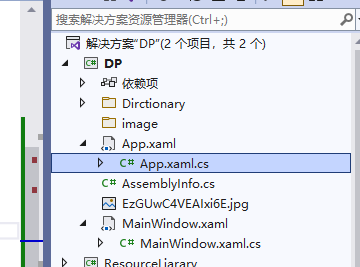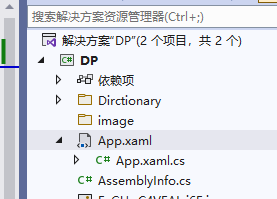【WPF】应用程序设置Application
1、WPF应用程序添加splashScreen(初始屏幕),
(1)跟目录导入图片
(2)在App.xaml.cs文件中输入以下代码

protected override void OnStartup(StartupEventArgs e) { base.OnStartup(e); SplashScreen splashScreen = new SplashScreen("EzGUwC4VEAIxi6E.jpg"); splashScreen.Show(true); }
2、设置应用程序的初始窗口
(1)在以下输入StartupUri="MainWindow.xaml" 是初始窗口的文件名

<Application x:Class="DP.App" xmlns="http://schemas.microsoft.com/winfx/2006/xaml/presentation" xmlns:x="http://schemas.microsoft.com/winfx/2006/xaml" xmlns:local="clr-namespace:DP" ShutdownMode="OnMainWindowClose" StartupUri="MainWindow.xaml"> </Application>
3、设置应用程序的关闭方式
(1)在以下输入ShutdownMode="OnMainWindowClose"关闭模式,一种有3种 OnlastWindowClose、OnExplicitShutdown(强制调用 Application.shoutdown)、OnMainWindowClose
<Application x:Class="DP.App" xmlns="http://schemas.microsoft.com/winfx/2006/xaml/presentation" xmlns:x="http://schemas.microsoft.com/winfx/2006/xaml" xmlns:local="clr-namespace:DP" ShutdownMode="OnMainWindowClose" StartupUri="MainWindow.xaml"> </Application>
4、应用程序的窗体退出设置
在App.xaml.cs文件中输入以下代码
protected override void OnExit(ExitEventArgs e) { base.OnExit(e); MessageBoxResult messageBoxResult = MessageBox.Show("dfsf"); MessageBox.Show("sdfsfsd"); }
5、计算机注销或关键结束应用程序时设置
在App.xaml.cs文件中输入以下代码
protected override void OnSessionEnding(SessionEndingCancelEventArgs e)
{
base.OnSessionEnding(e);
MessageBoxResult messageBoxResult = MessageBox.Show("dfsf");
MessageBox.Show("sdfsfsd");
if(messageBoxResult == MessageBoxResult.No)
e.Cancel = true;
}
6、记录应用程序未处理异常
DispatcherUnhandedException事件没有触发事件。
在App.xaml中输入
<Application x:Class="DP.App" xmlns="http://schemas.microsoft.com/winfx/2006/xaml/presentation" xmlns:x="http://schemas.microsoft.com/winfx/2006/xaml" xmlns:local="clr-namespace:DP" DispatcherUnhandledException="Application_DispatcherUnhandledException" StartupUri="MainWindow.xaml"> </Application>
// 程序启动时注册DispatcherUnhandledException事件 private void Application_DispatcherUnhandledException(object sender, System.Windows.Threading.DispatcherUnhandledExceptionEventArgs e)
{
//设置异常已处理
e.Handled = true;
//异常处理
new ExceptionViewModel(e.Exception);
}
ExceptionViewModel用于显示具体的错误信息。
编程是个人爱好


